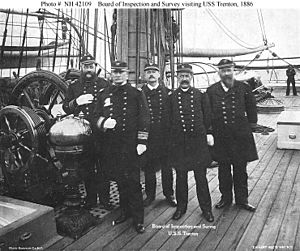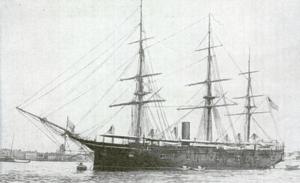USS Trenton (1876) facts for kids

Admiral James Edward Jouett (second from left) and others inspecting USS Trenton in 1886.
|
|
Quick facts for kids History |
|
|---|---|
| Name | USS Trenton |
| Namesake | Trenton, New Jersey |
| Builder | New York Navy Yard, Brooklyn, New York |
| Laid down | 1875 |
| Launched | 1 January 1876 |
| Commissioned | 14 February 1877 |
| Decommissioned | 9 November 1881 |
| Recommissioned | 19 September 1883 |
| Decommissioned | 17 September 1886 |
| Recommissioned | 16 May 1887 |
| Fate | Wrecked 16 March 1889 |
| Stricken | 13 April 1891 |
| General characteristics | |
| Type | Screw steamer |
| Displacement | 3,800 long tons (3,900 t) |
| Length | 253 ft (77 m) |
| Beam | 48 ft (15 m) |
| Draft | 20 ft 6 in (6.25 m) |
| Propulsion | Steam engine |
| Speed | 14 kn (16 mph; 26 km/h) |
| Complement | 477 officers and enlisted |
| Armament | 11 × 8 in (200 mm) muzzle-loading rifles, 2 × 20 pdr (9.1 kg) breech-loading rifles |
The first USS Trenton was a large wooden ship in the United States Navy. It was a "screw steamer," meaning it used a propeller powered by a steam engine. The ship was named after Trenton, New Jersey.
The Trenton was built at the New York Navy Yard starting in 1875. It was launched on January 1, 1876, and officially joined the Navy on February 14, 1877. Its first commander was Captain John Lee Davis.
A cool fact about the Trenton is that it was the first U.S. Navy ship to have electric lights. These lights were installed in 1883.
Contents
Early Missions in the Mediterranean (1877-1881)
The Trenton left New York on March 8, 1877, and sailed to Villefranche, France. Soon after, it became the main ship, or "flagship," for the U.S. Navy's ships in Europe.
While the Trenton was in the Mediterranean, a war started between Russia and Turkey. The Trenton and other U.S. ships took turns sailing in the eastern Mediterranean. Their job was to protect American citizens and other foreigners living in or visiting Turkish areas.
The ship visited many ports during this time. These included Smyrna, Turkey, Salonika, Marseilles, and cities in Italy like La Spezia and Leghorn.
In July 1878, the Trenton left the Mediterranean and sailed north. It visited Lisbon, Portugal; Cherbourg, France; and Yarmouth, England. Then, it returned to the Mediterranean.
The Trenton continued its travels, adding Genoa, Naples, and Tangiers to its list of stops. In June 1879, it sailed out again to visit Portsmouth, England, and ports in the Netherlands and Belgium.
Heroes on Board: Medal of Honor Winners
During these voyages, four sailors from the Trenton showed great bravery. They rescued other sailors from drowning and were given the Medal of Honor.
- Seamen Philip Moore and John Russell saved lives in Genoa, Italy, on September 21, 1880.
- Ordinary Seaman John Davis and Seaman Alexander Haure Turvelin were heroes in Toulon, France, in February 1881.
The Trenton stayed in the western Mediterranean until September 1881. It then sailed back to the U.S., arriving in Hampton Roads in October. After a celebration in Yorktown, the ship went to the New York Navy Yard. It was taken out of service on November 9, 1881.
Adventures in the Far East (1883-1886)
The Trenton was put back into service on September 18, 1883. In November, it began a long journey to the Asiatic Station (Asia). The ship traveled through the Mediterranean, the Suez Canal, past Ceylon, and Singapore. It finally reached Hong Kong on May 1, 1884.
For the next two years, the Trenton cruised around the Far East. It visited ports in China, Korea, and Japan. The ship carried out important diplomatic missions, which means it helped with official government business between countries.
Sometimes, the Trenton sent groups of sailors ashore in China and Korea. This was to protect American citizens and other foreigners when there was unrest or trouble in those areas.
The ship finished this duty in the spring of 1886. It left Yokohama, Japan, on May 9 and sailed all the way back to the U.S. It arrived in Hampton Roads on September 2. The Trenton was then taken out of service again for repairs on September 17, 1886.
Final Voyage to the Pacific (1887-1889)
On May 16, 1887, the Trenton was put back into service for its last mission. On July 25, it left Hampton Roads and sailed south towards Brazil. It stopped at St. Vincent and then arrived in Rio de Janeiro on September 10 for a two-week visit. After another stop, it returned to New York on November 3.
About three months later, on January 30, 1888, the Trenton set sail for the Pacific. This journey took over a year because the ship had to sail all the way around Cape Horn. This is the very southern tip of South America.
After stopping in Panama and Tahiti, the Trenton reached Apia, Samoa, on March 10, 1889. There, it joined other U.S. Navy ships.
The Great Cyclone of Apia
Just six days later, on March 16, 1889, a huge cyclone (a very strong storm) hit Apia. Thirteen ships were anchored in the harbor, and they were all in great danger.
For 36 hours, the storm raged. The Trenton lost its steam power and its steering. It was very close to crashing onto a reef. But Lieutenant Robert M. G. Brown, the ship's navigator, had a clever idea.
The commander, Norman von Heldreich Farquhar, ordered every sailor to climb into the ropes and sails on the left side of the ship. With the wind pushing against the large group of bodies, which acted like a giant sail, the ship was slowly steered away from the reef and into the bay.
The Trenton then bumped into a German ship called the SMS Olga. After that, it floated towards the sinking Vandalia. Because the Trenton crew was still in the rigging, their ship slowed down. This prevented another big crash. The Trenton was carefully moved alongside the Vandalia. This allowed the Vandalia's crew to escape onto the deck of the Trenton, saving many lives.
Both the Trenton and the Vandalia were badly damaged and later abandoned. Amazingly, out of 450 men on the Trenton's crew, only one sailor was lost. The Trenton was declared completely destroyed, and its name was removed from the Navy's list of ships on April 13, 1891.
First Ship with Electric Lights
The USS Trenton holds an important place in Navy history. It was the very first U.S. Navy ship to have electric lights. A special machine called a dynamo, an engine, and the lights were put on the ship in the summer of 1883. The success of using electricity on the Trenton led to electric lights being installed on the first ships of the "New Steel Navy," which were more modern warships.



